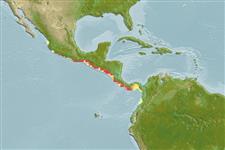Elasmobranquios (tiburones y rayas) (sharks and rays) >
Myliobatiformes (Stingrays) >
Urotrygonidae (American round stingrays)
Etymology: Urotrygon: Greek, oura = tail + Greek, trygon = a sting ray (Ref. 45335); cimar: Named for the Centro de Limnología (CIMAR) a research center of the Universidad de Costa Rica during its twentieth anniversary..
Environment: milieu / climate zone / depth range / distribution range
Ecología
marino demersal; rango de profundidad 0 - 85 m (Ref. 40883), usually ? - 10 m. Tropical
Distribución
Países | Áreas FAO | Ecosistemas | Ocurrencias, apariciones | Point map | Introducciones | Faunafri
Eastern Central Pacific: between Corinto, Nicaragua and Gulf of Nicoya, Costa Rica.
Tamaño / Peso / Age
Maturity: Lm ? range ? - ? cm
Max length : 38.2 cm TL macho / no sexado; (Ref. 40883)
Short description
Morfología | Morfometría
Large species of Urotrygon with a round disc; tail short. Dorsal surface of disc and tail yellow-brown or tan irregularly spotted with brown or black blotches; ventral surface of disc white with lateral margins of disc and posterior border of pelvic fins tan in juveniles, dark brown or gray in adults. Small pungent denticles densely cover dorsal surface of disc and tail; denticles only slightly enlarged near midline. Pupillary operculum a small triangle, apex not reaching ventral margin of pupil.
Found in tide pools and to a depth of 85 m. Usually collected in waters shallower than 10 m.
Life cycle and mating behavior
Madurez | Reproducción | Puesta | Huevos | Fecundidad | Larva
López S., M.I. and W.A. Bussing, 1998. Urotrygon cimar, a new eastern Pacific stingray (Pisces: Urolophidae). Rev. Biol. Trop. 46 (Suppl. 6):271-277. (Ref. 40883)
IUCN Red List Status (Ref. 130435)
Threat to humans
Harmless
Human uses
Más información
PaísesÁreas FAOEcosistemasOcurrencias, aparicionesIntroduccionesStocksEcologíaDietacomponentes alimenticiosconsumo de alimentoRación
Age/SizeCrecimientoLength-weightLength-lengthLength-frequenciesMorfometríaMorfologíaLarvaDinámica larvariaReclutamientoAbundanciaBRUVS
ReferenciasAcuiculturaPerfil de acuiculturaRazasGenéticaElectrophoresesheritabilidadEnfermedadesProcesamientoNutrientsMass conversion
ColaboradoresImágenesStamps, Coins Misc.SonidosCiguateraVelocidadTipo de nataciónSuperficie branquialOtolitosCerebrosVisión
Herramientas
Special reports
Download XML
Fuentes de Internet
Estimates based on models
Preferred temperature (Ref.
123201): 27.9 - 29.1, mean 28.5 °C (based on 98 cells).
Phylogenetic diversity index (Ref.
82804): PD
50 = 0.5001 [Uniqueness, from 0.5 = low to 2.0 = high].
Bayesian length-weight: a=0.01413 (0.00575 - 0.03468), b=3.07 (2.86 - 3.28), in cm total length, based on LWR estimates for this (Sub)family-body shape (Ref.
93245).
Nivel trófico (Ref.
69278): 3.7 ±0.6 se; based on size and trophs of closest relatives
Resiliencia (Ref.
120179): Bajo, población duplicada en un tiempo mínimo de 4.5-14 años (Assuming fecundity<100).
Fishing Vulnerability (Ref.
59153): Low to moderate vulnerability (28 of 100).
